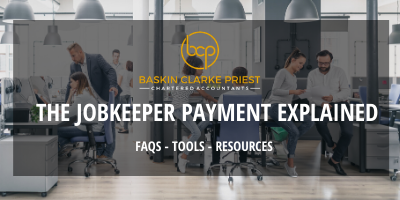Grappling with Turnover? How to get it right for the Jobkeeper payment.
BusinessPromoted by Baskin Clarke Priest
How will accountants and tax professionals navigate defining and determining turnover for SMEs when establishing criteria for the JobKeeper scheme?

The sheer breadth of current stimulus measures is astounding and navigating the complexities of initiatives such as the JobKeeper Payment is placing an extraordinary amount of pressure on accounting and tax professionals, in what is already an unprecedented time of stress.
According to Vanessa Priest, Member of The Tax Institute COVID-19 Stimulus Rapid Response Group and a Tax Director at Baskin Clarke Priest, one of the most vital aspects of the Jobkeeper payment rules is understanding what is meant by turnover.
There are three main issues when defining turnover for the JobKeeper scheme:
- A restricted test for the decline in turnover.
One of the key conditions to access the Jobkeeper payment is a decline in turnover of 30% or more (for SMEs).
The turnover test period (either one of the months from March to September 2020, or the June or September 2020 quarter) has to be compared to the relevant period from 12 months earlier. Consequently, this excludes start-ups; neither does it take into account businesses with “lumpy” turnover, or ones where the business has been steadily scaling up. There is an alternative test available, however the Commissioner only makes this determination if he is satisfied that there is not an appropriate relevant comparison period. This is done by a Legislative Instrument, which we are currently waiting on. It is anticipated it will give discretion to the Commissioner to establish eligibility applying different comparison periods.
- Which definition of Turnover?
The turnover referred to in the decline in turnover test is the GST projected turnover. The GST definition of projected turnover includes all supplies, other than input taxed supplies, and supplies made from an overseas location by the business. Further, if a business is in a GST group, you are required to “de group” and apply the decline in turnover test to the separate entities.
One anomaly that also arises from applying the test per entity (and not per business group) is that businesses with separate service entities, which is common in many professional service businesses, will rarely be able to access Jobkeeper for their employees notwithstanding they have suffered a significant decline in turnover.
Further, by excluding input taxed supplies, companies with more passive type activities (such as investment companies) won’t be able to access Jobkeeper.
To add further confusion, to determine whether the relevant threshold is a decline in turnover of 30% or more (less than $1billion turnover) or 50% or more (more than $1billion turnover), turnover in this threshold test refers to the aggregate turnover of the entity, which is different to GST projected turnover. Turnover for these purposes includes all income from carrying on a business, as well as the business turnover of connected entities, which can include foreign parents and/or subsidiaries, and affiliates.
- Not getting it right.
If the business was not eligible for JobKeeper payments, any overpayment must be repaid, by the employer, with GIC (although there is the ability for the Commissioner to decide not to require repayment). The legislation also provides for a joint and several liability, that could, on the face of it, subject advisers that have failed to take reasonable care, to be liable for the repayment of a JobKeeper overpayment amount.
Vanessa adds that given these complexities and the potential fallout if errors are made, it is of paramount importance to carefully record how the turnover was determined, show what periods were applied as the test periods (and the comparison period) and document your conclusions as to why the JobKeeper payment is available.
Vanessa Priest is running a webinar next week covering these issues. Click here to learn more about THE Definitive COVID-19 Stimulus Review (SME edition) webinar and access our exclusive CoronaVirus Tax Essentials Package.
Prepare ahead with CoronaVirus Tax Essentials Package.
Not available anywhere else, this customised and integrated solution is the only resource you will need to navigate the complexities of the COVID-19 measures for SMEs.
An all-inclusive resource that includes:
- Expert Insights: A 90minute webinar with live Q&As, interactive panel discussion and more.
- Comprehensive Content. An in-depth guide that details all the new Government initiatives with visual overviews of the initiatives, their timings and more.
- Eligibility Tool. An easy-to-use interactive tool to guide you through the myriad of eligibility conditions;
- FAQ Library: An indispensable collation of FAQs that will prove invaluable through the upcoming BAS and tax season;




You are not authorised to post comments.
Comments will undergo moderation before they get published.